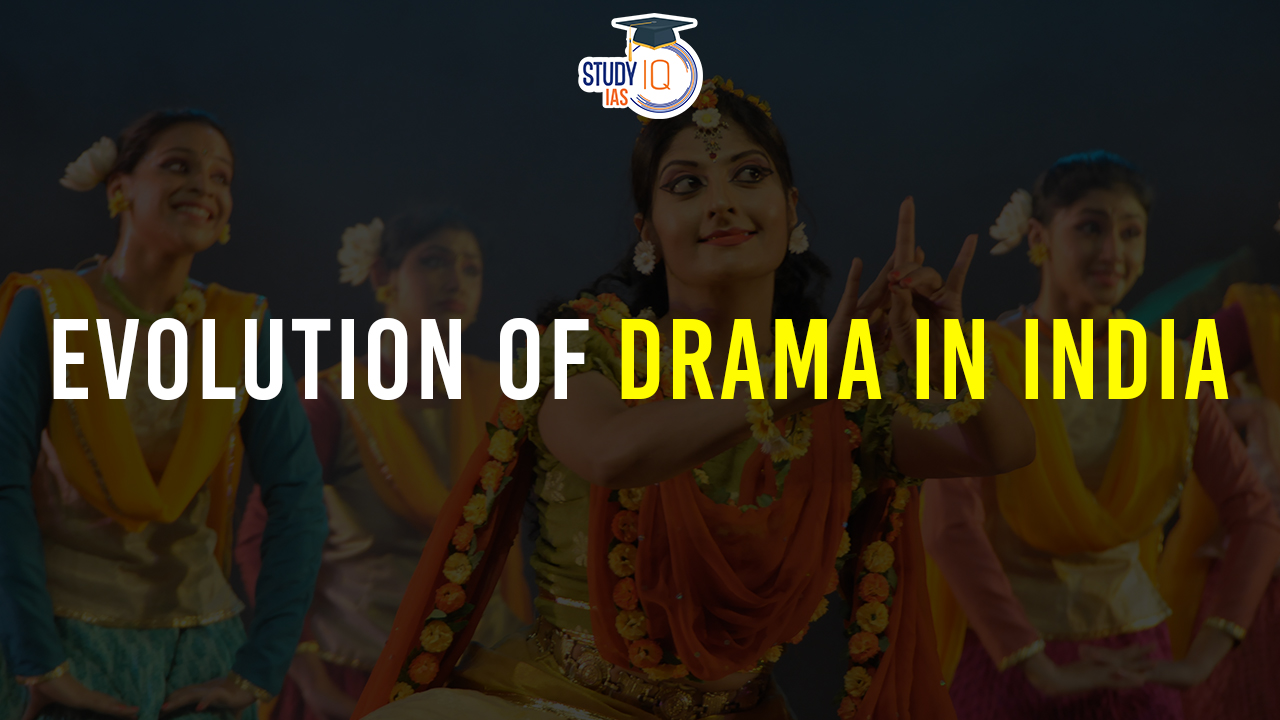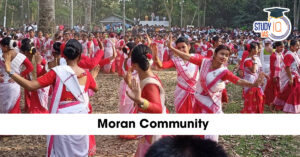Table of Contents
The evolution of drama in India is a rich and diverse journey that spans centuries and reflects the country’s cultural, social, and historical changes. Indian drama has its roots in ancient theatrical traditions and has evolved over time, incorporating influences from various regions, languages, and cultural practices. Here is an overview of the evolution of drama in India.
We’re now on WhatsApp. Click to Join
Origin of Drama in India
The roots of drama in India can be traced back to the Rigveda, which was written between 1200 and 1500 BCE. The Rigveda contains hymns in the form of dialogues and scenes, as well as hymns that use other literary forms.
Indian theatre dates back to the 2nd century BC. It began in ritualistic practices and took formal shape through Sanskrit drama. Notable playwrights who contributed to the development of Sanskrit drama include Bhasa and Kalidasa.
The golden period of Sanskrit drama began in the 2nd century BCE and ended in the 10th century CE. The decline of Sanskrit drama was caused by several foreign invasions and rulers that banned the art form.
Indian theater has a diverse history. Its forms differed from region to region, but they were all committed to the idea that theater can be a force for social change. The states with the largest theater movements were Uttar Pradesh, Delhi, Maharashtra, Bengal, Punjab, Andhra Pradesh, and Kerala.
Check here: Famous Modern Dramas and Dramatists
Ancient Indian Drama (2nd century BCE-10th century CE)
The origins of Indian drama can be traced back to the Natya Shastra, a comprehensive treatise on performing arts attributed to the ancient sage Bharata Muni. Composed between the 2nd century BCE and the 2nd century CE, this foundational text outlined the principles of dramatic theory, encompassing aspects of acting, music, dance, and stagecraft. It provided a systematic guide for the creation and performance of drama.
Sanskrit drama flourished during this period, and its golden age is often associated with renowned playwrights such as Kalidasa, Bhasa, and Shudraka. Kalidasa’s plays, such as “Shakuntala” and “Malavikagnimitram,” are celebrated for their poetic beauty, intricate plots, and exploration of human emotions. Bhasa, though relatively less known due to the loss of many of his works, is recognized for his innovation and experimentation in dramatic form.
The performance of these early dramas was closely tied to religious and courtly contexts, with royal patronage supporting the arts. The Natya Shastra classified drama into ten major types, providing a framework for the diverse narratives that could be presented on stage, ranging from mythological epics to tales of everyday life.
Medieval Indian Drama (10th-18th Century)
The medieval period witnessed the diversification of theatrical traditions across different regions of India. Local forms of drama began to emerge, often influenced by regional folklore, traditions, and cultural practices. These performances were not confined to Sanskrit but were conducted in various regional languages.
In Maharashtra, the Tamasha tradition incorporated elements of dance, music, and humor. Gujarat saw the development of Bhavai, a folk theater form that combined social commentary with entertainment. Bengal witnessed the rise of Jatra, a popular folk theater form that traveled from village to village, narrating stories of mythology and contemporary issues.
Despite the regional variations, these forms of drama often retained a connection to religious themes, folk tales, and societal values. They served as a means of both entertainment and cultural expression for the local communities.
Colonial Era (18th-19th century)
The colonial era marked a significant shift in Indian drama due to the influence of British colonialism. English-language plays became prominent, reflecting Western theatrical traditions. The proscenium stage became popular, and European-style theaters were established in major cities.
Notable figures like Raja Ram Mohan Roy recognized the potential of theater as a tool for social reform and education. Playwrights such as Michael Madhusudan Dutt and Dinabandhu Mitra began to write plays in English and Bengali, addressing social issues, promoting education, and challenging traditional norms.
Modern Indian Drama (20th Century-Present)
The 20th century brought about a renaissance in Indian drama with the emergence of influential playwrights. Rabindranath Tagore, a Nobel laureate in literature, contributed significantly to the fusion of traditional Indian drama with Western influences. His plays, like “The Post Office” and “Muktadhara,” explored humanism and spirituality.
Girish Karnad, a prominent playwright and filmmaker, delved into historical and mythological themes. Vijay Tendulkar, through works like “Shantata! Court Chalu Aahe” (Silence! The Court is in Session), addressed social and political issues, challenging societal norms and advocating for change.
The Indian People’s Theatre Association (IPTA), formed in the 1940s, played a pivotal role in using theater as a medium for social and political commentary. Experimental and avant-garde theater gained momentum, with playwrights like Badal Sircar exploring new forms and styles.
Contemporary Indian Drama (21st century – present)
In the 21st century, Indian drama continues to evolve with the emergence of new voices and forms. The influence of globalization, technology, and social media has impacted the way stories are told and consumed. Playwrights and theater practitioners explore diverse themes, experiment with styles, and often draw inspiration from both traditional and modern sources.
Contemporary Indian drama is characterized by its diversity, reflecting the complex and dynamic nature of Indian society. Issues such as identity, gender, politics, and globalization are explored on stage, providing a platform for dialogue and reflection. The theater scene is not limited to metropolitan areas; smaller cities and towns also witness a growing interest in drama, fostering a more inclusive and widespread theatrical culture.
In conclusion, the evolution of drama in India is a fascinating journey that spans millennia, reflecting the country’s cultural richness and adaptability. From the ancient Sanskrit plays to the diverse regional forms, the impact of colonialism, and the dynamism of contemporary theater, Indian drama continues to be a powerful medium for storytelling and cultural expression.
Types of Drama in India
India has a rich tradition of various types of drama, encompassing a wide range of styles, themes, and regional variations. Here are some of the prominent types of drama in India:
Sanskrit Drama
- Sanskrit drama, dating back to ancient times, is characterized by classical texts like those of Kalidasa and Bhasa. It follows the guidelines outlined in the Natya Shastra and often features intricate plots, poetic language, and a combination of music and dance.
Folk Drama
- India has a diverse range of folk traditions, each with its own unique forms of drama. Examples include:
- Tamasha (Maharashtra): A lively folk form that combines dance, music, and drama. It often portrays social issues in a humorous way.
- Bhavai (Gujarat): A vibrant form of folk theater known for its colorful costumes, energetic music, and social commentary.
- Jatra (Bengal): A popular folk theater form that involves traveling troupes, narrating stories of mythology and contemporary issues.
Yakshagana
- Originating in Karnataka, Yakshagana is a traditional dance drama that combines elements of dance, music, dialogue, and elaborate costumes. It often depicts episodes from the epics like the Mahabharata and Ramayana.
Koodiyattam
- Originating in Kerala, Koodiyattam is one of the oldest existing forms of Sanskrit theater. It involves highly stylized and ritualistic performances, often based on ancient Hindu texts.
Nautanki
- Popular in North India, particularly in Uttar Pradesh, Nautanki is a form of musical drama characterized by lively music, dance, and exaggerated acting. It often tells stories of romance and social issues.
Puppet Theater
Puppetry has a strong tradition in India, with various forms such as:
- Kathputli (Rajasthan): String puppetry with colorful wooden puppets, often used to narrate folk tales and myths.
- Bommalattam (Tamil Nadu): Shadow puppetry using leather puppets to depict stories from epics.
Contemporary Theater
Modern Indian drama has evolved to address contemporary issues and diverse themes. Playwrights like Vijay Tendulkar, Girish Karnad, and Badal Sircar have contributed to this form, often using theater as a medium for social and political commentary.
Street Theater (Nukkad Natak)
Street plays are a popular form of dramatic expression, addressing social issues and raising awareness. They are performed in public spaces to engage a wide audience.
English-Language Theater
With the influence of colonialism, English-language theater gained prominence in India. Contemporary playwrights continue to write in English, addressing global and local themes.
Experimental and Avant-Garde Theater
In the 20th century and beyond, there has been a surge in experimental theater, challenging traditional norms and exploring new forms of expression. The Indian People’s Theatre Association (IPTA) played a significant role in promoting experimental theater.
Evolution of Drama in India UPSC
The origins of Indian drama can be traced to the Rigveda, with hymns containing dialogues and scenes. The formalization of Indian theater began in the 2nd century BCE with Sanskrit drama, featuring playwrights like Bhasa and Kalidasa. The golden age of Sanskrit drama, spanning the 2nd century BCE to the 10th century CE, faced decline due to foreign invasions.
Regional variations in drama flourished, driven by the belief in theater as a force for social change. The medieval period saw diverse forms like Maharashtra’s Tamasha and Bengal’s Jatra. The colonial era introduced English-language plays, and the 20th century witnessed a renaissance with playwrights like Tagore and Karnad. Contemporary Indian drama, marked by diversity and social exploration, continues to evolve in the 21st century.


 Poompuhar Port: Ancient Sangam-Era Marit...
Poompuhar Port: Ancient Sangam-Era Marit...
 UNESCO World Heritage Sites of India Lis...
UNESCO World Heritage Sites of India Lis...
 Moran Community of Assam, History, Langu...
Moran Community of Assam, History, Langu...

























